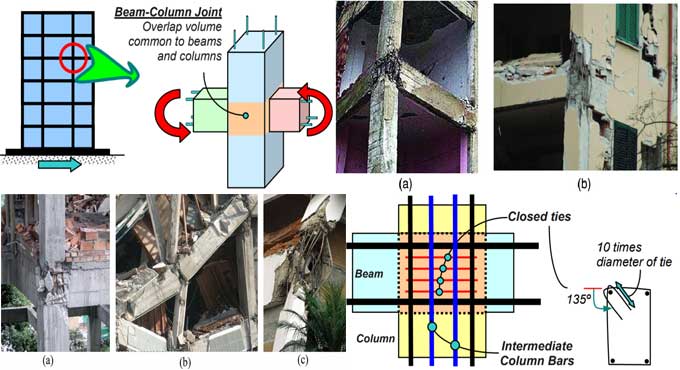NEWS | SOFTWARE | SHEET
What you need to know about Beam Column Joints that resist Earthquakes
In RC buildings, beam column joints are elements of a column that are assembled with a beam at its intersection. The joints are limited in force carrying capability due to the limited strength of their constituent materials.
An earthquake can cause severe damage to joints when forces larger than these are applied. It is difficult to repair damaged joints, so it is important to avoid damage as much as possible. It is essential to design beam column joints that can withstand earthquakes.
Behavior of Joints for Earthquake
The concrete fails to grip the steel bars if the column is too narrow or the concrete in the joint is too weak. Under such conditions, the bar slips inside the joint region, and beams lose their load-bearing capacity.
When a joint is shaken by an earthquake, both adjacent beams are subjected to moments in the same direction. That leads to pulling in one direction of the top bars and pulling in the other direction of the bottom bars in the joints between beams and columns. The bond stress between concrete and steel balances these forces in the joint region.
Beam Bars Anchoring:
Using columns of reasonably large cross sectional size first improves the gripping of beam bars in the joint region. Building columns in seismic zones 3,4 & 5 are at least 300mm wide in both directions of the column cross section if they support beams longer than 5m or if the columns are taller than 4m between floors. Conversely, the American Concrete Institute recommends columns are 20 times wider than the largest longitudinal bar in adjoining beams.
- Longitudinal beam bars must be anchored into the column to ensure proper grip on longitudinal beam bars in exterior joints where beams terminate at columns.
- It is about 50 times the diameter of a bar of grade Fe415 to anchor it. An anchored bar's length is measured from its end to the face of the column.
- The top bar of the beam overhangs a portion of the column that is cast up to the soffit of the beam in columns of narrow widths and large diameters.
- Casting the column up to the soffit of the beam is difficult with an overhanging beam top bar. Furthermore, anchorage is not very effective beyond the 90 degree bend in beam bars.
- A wide column width may prevent beam bars from extending below the soffit if the column width is wide. In this regard, it is best to have columns that are wide enough.
- There are many codes that rely on this approach. For interior joints, both the top and bottom beam bars must pass through the joint without any cuts. Also, the bars should be positioned inside the column bars without being bent.
Beam Column Joint Reinforcement
For RC frame buildings to perform well during earthquakes, diagonal cracking & crushing of concrete should be prevented. The most effective way to achieve this is to use large columns.
- Concrete in the joint region must be held together and resist shear forces by close loop steel ties.
- Shear forces are also inhibited by intermediate column bars by confining the joint concrete.
- Ties with closed loops at joints require some extra effort. A transverse loop should be continued around the column bars through the joint region according to Indian Standard.
- In practice, this is done by erecting the reinforcement cage at floor level, then lowering it into the cage onto the formwork of the beam at that level. When beams are long & the reinforcement cage is heavy, this may not always be possible.
To get more details, go through the following video tutorial.
Lecturer: Civil Engineering


